I. What are the Processes of Clonal Selection and Maturation?
The phrase “trust the process” is something we like to live by here at MedLife Mastery because it really applies to everything in life. It can apply to you guys right now taking the MCAT, eventually applying to medical school to become future physicians or going to the gym to meet the various goals you’ve set for yourself.
In a way, the building of a mature immune response has a similar sentiment of “trusting the process” as well! It takes time and complex effort in order to eventually generate the combination of cells and tissues which all work together in an intricate way to act as our body’s main defense system. Let’s go ahead and delve into the main processes by which an effective immune response is generated!
II. Immunological Processes
The main immunological processes that occur in order for us to generate an effective immune response include clonal selection and lymphocyte (adaptive immune cell) maturation — the maturation of the innate immune cells are also important but are beyond the scope of the MCAT.
A. Clonal Selection
Recall that the specificity of the B and T cell receptors is what results in a much stronger immune response from the adaptive immune system. However, because it takes time for the specific B and T cells with the corresponding receptors to be selected for during clonal selection, the response of the adaptive immune system occurs in a much longer duration.
Once the specific B and T cell lymphocytes have been selected for, they are stimulated to expand and proliferate. In addition they differentiate into 2 main types of cells: effector cells which migrate to the site of infection to eradicate the pathogen or memory cells which act as a reservoir so that upon subsequent infection of the same pathogen, the adaptive immune response generated can occur much faster!
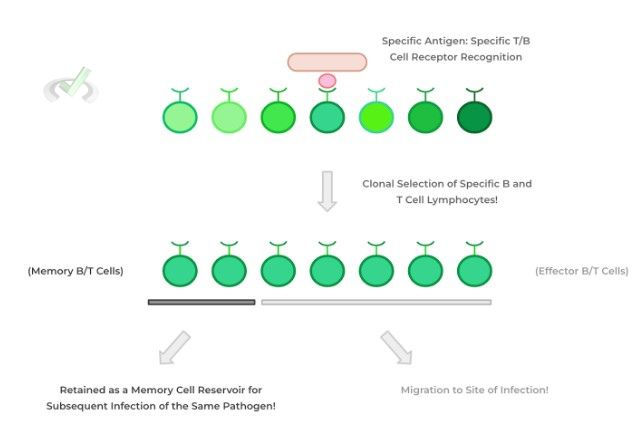
B. Lymphocyte Maturation
The maturation of lymphocytes is fairly complex due to the necessary steps and safety mechanisms that are put in place in order to ensure both a strong immune response but also avoid the possibility of an autoimmune reaction where the immune cells begin to attack the host tissue!
There are 3 main steps which occur during the process of lymphocyte maturation: 1) somatic recombination, 2) positive selection, and 3) negative selection.
I. Somatic Recombination
Recall that the central hallmark of the adaptive immune system is the specificity by which it can mount an immune response. Unlike the innate immune cells which have receptors that recognize a broad range of pathogen molecules, lymphocytes have receptors specific for a particular antigen.
This wide range of unique receptors which are specific to a particular antigen is accomplished via a process called somatic recombination. Simply put, there are various genes which code for the Fab region of light and heavy chains.
In somatic recombination, the various genes can actually be spliced and recombined in various different combinations in order to achieve a B/T cell receptor that’s unique and specific to a particular antigen. Note however that this splicing occurs at the level of DNA, not RNA as seen in traditional splicing!
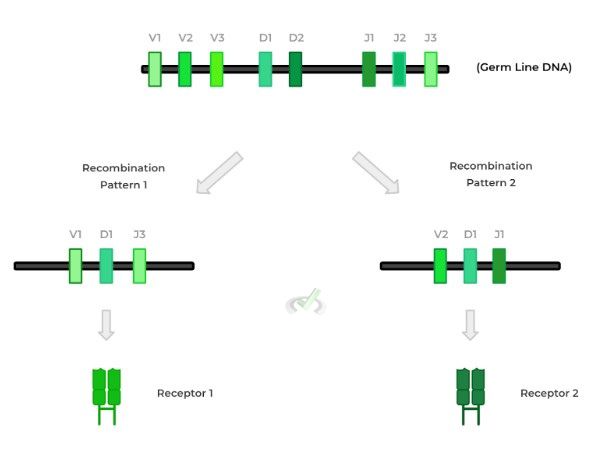
II. Positive Selection
We’ll primarily focus on positive selection in the scope of the T cell lymphocytes as the MCAT doesn’t focus on B cell positive selection. Positive selection simply tests whether the T cell receptor can successfully bind to an antigen and more importantly the MHC class molecule.
This process occurs at the thymus which is where T cells further mature while B cells continue to mature in the bone marrow!
Recall that the MHC class molecule is a presentation protein which allows for the presentation of antigens towards T cell receptors — as such, it’s important in positive selection to ensure that T cells can bind to the HOST MHC molecules in order to recognize the antigens presented!
If the T cell receptor can successfully bind to an antigen and a host MHC class molecule, it successfully passes positive selection and can continue on to negative selection. If no binding to the MHC class molecule is successful, the developing T cell undergoes apoptosis.
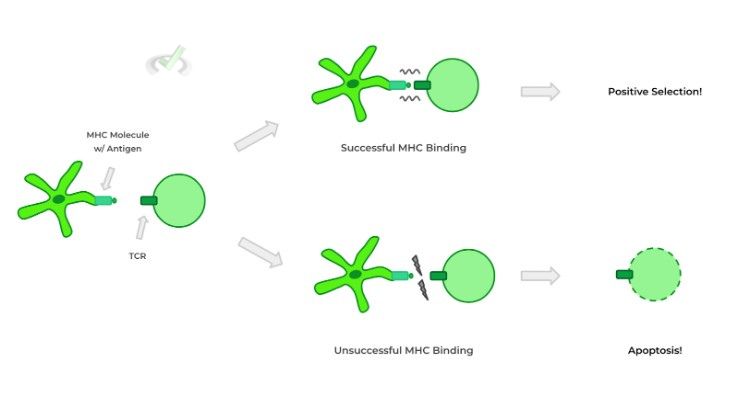
Additionally, it’s also at this stage of T cell maturation where T cells will differentiate into what type of T cell they’ll become. If the TCR binds strongly to a MHC Class I molecule, it’ll differentiate into a CD8⁺ cytotoxic T cell. If it binds strongly to a MHC Class II molecule, it’ll differentiate into a CD4⁺ helper T cell.
III. Negative Selection
In the final stage of maturation, T cell lymphocytes undergo negative selection in order to ensure there are no T cells which are self-reactive to host antigens! As we mentioned before, this strict regulation of host tissue recognition is crucial in order to decrease the likelihood of having an autoimmune attack!
Within the thymus, a special group of cells called the thymic epithelial cells can allow for the expression of various antigen throughout the body via the AIRE gene. The expression and presentation of systemic antigens is important so as to see if there are T cells that are self reactive to host tissue antigens outside the thymus!
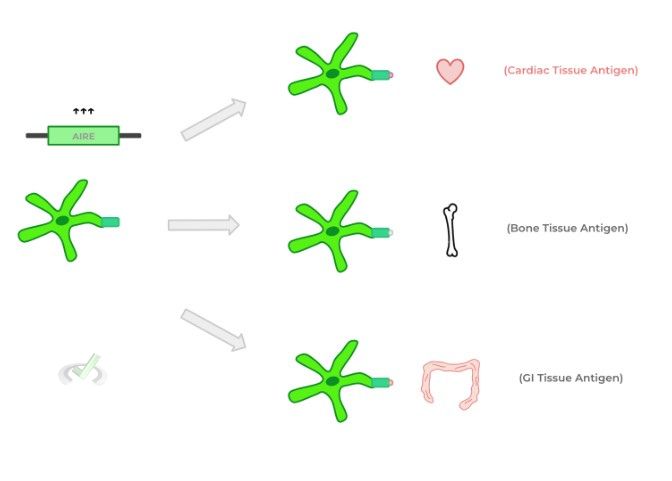
As mentioned in negative selection, the T cell receptor DOES NOT bind strongly to a self-antigen, then it passes negative selection and can finally develop into a mature (though naive) effector cytotoxic or helper T cell. If the T cell receptor DOES bind strongly to the self-antigen presented, then the T cell similarly undergoes apoptosis like in positive selection.
Additionally, note following negative selection, the T cells are termed mature, but naive. They are mature in the sense that they passed all the checkpoint along T cell maturation but are still naive because they have not yet encountered the antigen their receptors are specific for.
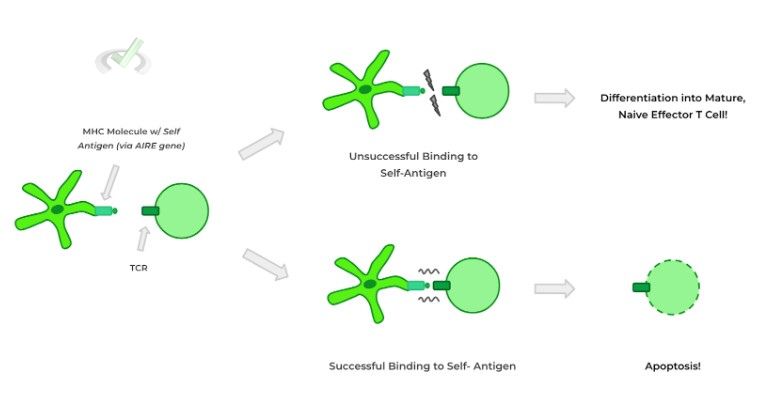
As we’ve seen, collectively all these processes work together in order to ensure the proper development of maturation of B and T cells to allow for the immune system to function! It’s definitely amazing to appreciate all these various intricacies that occur within the human body.
III. Bridge/Overlap
Being on the topic of clonal selection, recall that it’s because of this process that we can develop immunological memory and have a stronger response for subsequent infections. Let’s go ahead and review the concept of primary (1˚) and secondary (2˚) infection and their relation to clonal expansion!
I. Primary (1˚) and Secondary (2˚) Infection and Clonal Selection
Recall that the primary infection refers to when an individual first encounters a pathogen. At this point, the T and B cells with the specific receptors for that pathogen are present but are still undergoing clonal expansion in order to generate enough of those lymphocytes to mount an effective immune response.
An important component of this expansion is also the generation of memory T and B cells which serve as a reservoir for future infections. Secondary infections refer to subsequent infections which occur after the primary infection — because there’s now a reservoir of memory B and T cells which have been generated via clonal expansion, the adaptive immune response can occur much faster so that the infection can be cleared quicker!
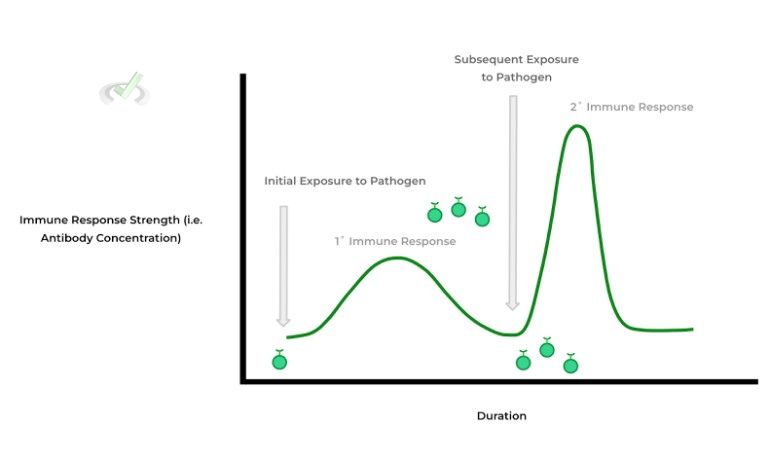
IV. Wrap Up/Key Terms
Let’s take this time to wrap up & concisely summarize what we covered above in the article!
A. Clonal Selection
When a pathogen encounters an antigen, it takes time for the B and T cells with the receptor specific for the pathogenic antigen to be selected to proliferate in order to generate an abundant amount of those lymphocytes in order to mount an effective adaptive immune response.
Recall as well that clonal selection is responsible for the faster immune response which occurs after primary infection due to the fact that there is now a reservoir of memory B and T cells which can enact a faster immune response!
B. Maturation
There are 3 main steps in regards to maturation of the adaptive immune system lymphocytes: 1) somatic recombination, 2) positive selection, and 3) negative selection.
I. Somatic Recombination
Within precursor lymphocytes, there are various genes and segments which contribute to the variability of the antigen binding region of B and T cell receptors.
At the level of the germline DNA, these various gene segments can be recombined in various ways in order to generate receptors of varying specificity which allows the lymphocytes to recgonize a wide variety of pathogenic antigens with high precision.
II. Positive Selection
Specifically for T cell maturation, positive selection will determine whether a T cell can bind strongly to self MHC molecules. Also note that T cell maturation continues in the thymus while B cells continue maturing in the bone marrow. If binding does occur, the T cell moves on to negative selection. If binding does not occur, the developing T cell undergoes apoptosis.
In addition, if the TCR recgonizes a MHC class I molecule, it’ll differentiate into a CD8 cytotoxic T cell while those recognizing MHC class II molecules will differentiate into a CD4 helper T cell.
III. Negative Selection
Finally, negative selection ensures that the developing T cells aren’t self-reactive to host antigens as these can cause an autoimmune response! The thymic epithelial cells can present antigens outside of the thymic tissue via the expression of the AIRE gene!
In this case, if the T cells bind strongly to self-antigens, they undergo apoptosis. If the T cells don’t bind strongly, they passes negative selection and become a mature, naive effector T cell!
V. Practice
Take a look at these practice questions to see and solidify your understanding!
Sample Practice Question 1
DiGeorge Syndrome is a genetic condition characterize by a chromosome 22q11.2 deletion syndrome. This results in faulty development of the pharyngeal arches which is a precursor to thymus formation. As such, which of the following immune cells would undergo faulty development?
A. T Cells
B. B Cells
C. T and B Cells
D. None
Ans. A
Recall that after somatic recombination, the developing T cells will migrate to the thymus in order to further mature via positive and negative selection while the B cells continue maturation in the bone marrow As only the thymus is the faulty developed organ, only the production and maturation of T cells would be affected.
Sample Practice Question 2
There are many different types of MHC class molecules that exist within the immune system. Suppose an individual has an MHC molecule subtype of MHC-A. Why is it important for this individual if they’re receiving a stem cell transplant to also receive immune stem cells that also came from an individual who expresses MHC-A?
A. Because the donor immune cells will also recognize MHC-A molecules as they also went through positive selection for this MHC subtype
B. Because the donor immune cells will also recognize MHC-A molecules, as they also went through negative selection for this MHC subtype
C. Because the donor immune cells will also won’t recognize self-antigens, as they also went through negative selection
D. Because the donor immune cells will will also recognize MHC-A molecules, as they also went through negative selection
Ans. A
Recall that positive selection refers to ensuring that the TCR will bind to self MHC antigens. Because the donor immune cells will also have undergo positive selection for the MHC-A subtype in the donor thymus, they should theoretically also be able to recognize the MHC-A subtype in the recipient body.


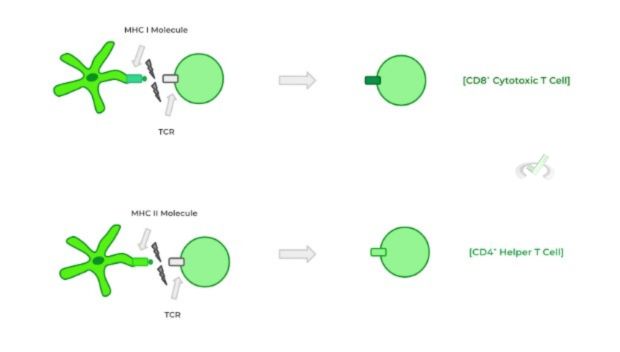





 To help you achieve your goal MCAT score, we take turns hosting these
To help you achieve your goal MCAT score, we take turns hosting these 





















 reviews on TrustPilot
reviews on TrustPilot